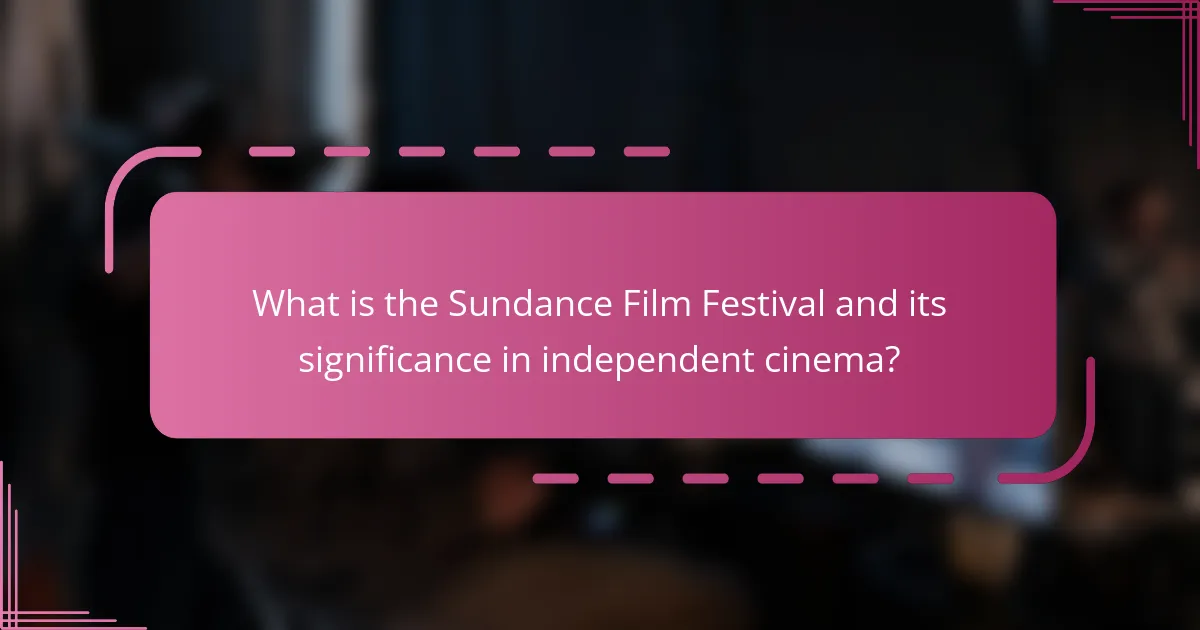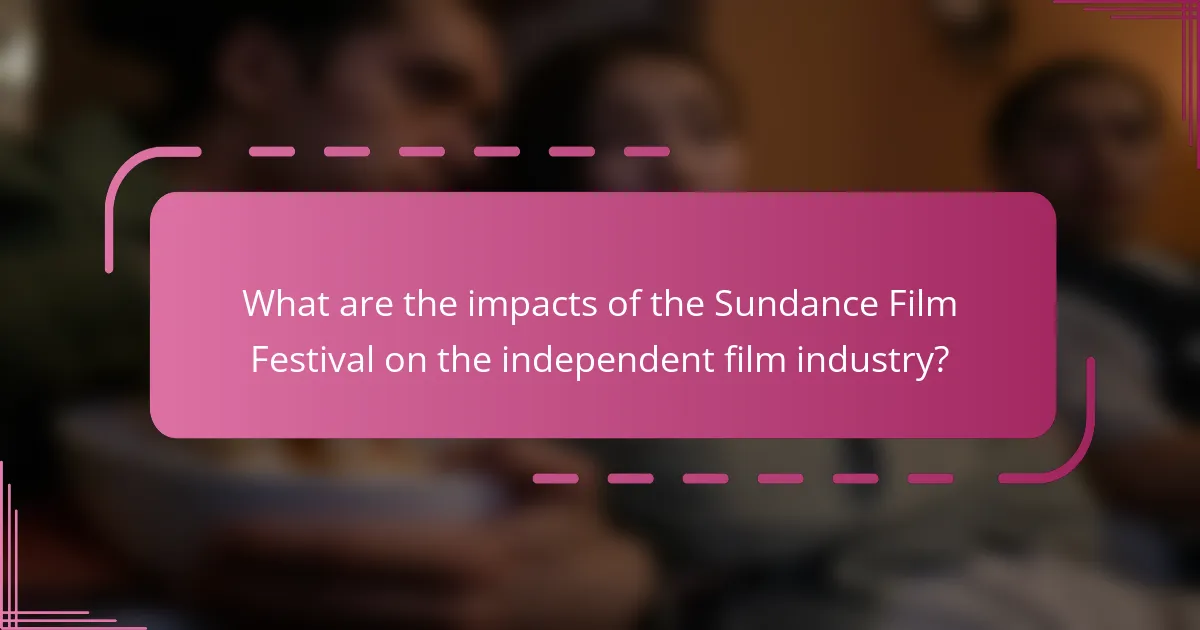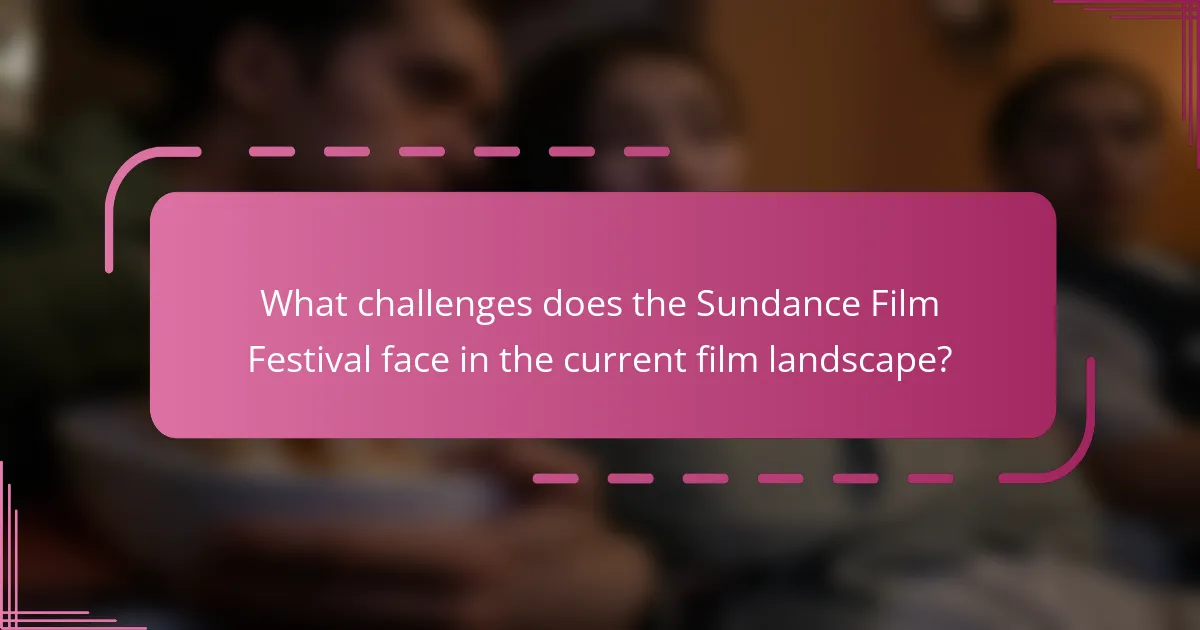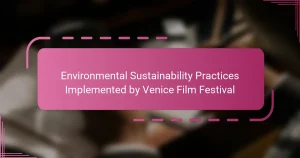The Sundance Film Festival is a significant annual event held in Park City, Utah, dedicated to independent cinema. Established in 1978, it showcases a wide array of films from both emerging and established filmmakers, playing a crucial role in launching careers and promoting diversity in storytelling. Notable films such as “The Blair Witch Project” and “Little Miss Sunshine” gained recognition through their Sundance premieres. However, the festival faces challenges in the current film landscape, including competition from streaming platforms, shifts in audience preferences, and funding difficulties, which impact its ability to effectively promote independent cinema.

What is the Sundance Film Festival and its significance in independent cinema?
The Sundance Film Festival is an annual film festival held in Park City, Utah. It is one of the largest and most prestigious festivals dedicated to independent cinema. Established in 1978, the festival showcases a diverse range of films from emerging and established filmmakers. Sundance serves as a platform for independent filmmakers to present their work to a larger audience. It has played a crucial role in launching the careers of many filmmakers. Notable films like “The Blair Witch Project” and “Little Miss Sunshine” gained prominence after their Sundance debuts. The festival also attracts significant media attention, which helps in promoting independent films. Overall, Sundance is significant for its impact on the visibility and viability of independent cinema.
How did the Sundance Film Festival originate?
The Sundance Film Festival originated in 1978 as the Utah/US Film Festival. It was founded by a group of filmmakers and supporters, including Robert Redford. The festival aimed to promote independent filmmakers and showcase their work. In 1981, the festival was renamed the Sundance Film Festival. This change reflected the growing influence of the Sundance Institute, which Redford established to support independent artists. The festival has since become a premier platform for independent cinema. It has significantly impacted the film industry by launching numerous successful careers and films.
What were the key milestones in the festival’s history?
The Sundance Film Festival has several key milestones in its history. It was founded in 1978 as the Utah/US Film Festival. In 1981, it was renamed the Sundance Film Festival. The festival gained prominence in the 1990s, showcasing films like “[censured], Lies, and Videotape.” In 1995, it launched the Sundance Institute’s Film Festival Labs. The festival became a platform for independent filmmakers, significantly impacting the industry. In 2001, it introduced the Audience Award, which has since recognized popular films. By 2010, the festival expanded to include new media and documentary categories. Today, it remains a crucial event for independent cinema.
How has the festival evolved over the years?
The Sundance Film Festival has evolved significantly since its inception in 1978. Originally a small event, it aimed to showcase independent films. Over the years, it has grown into a major platform for filmmakers. In the 1990s, it gained international recognition, attracting more attendees and media coverage. The festival introduced new categories and awards to highlight diverse storytelling. Technological advancements have also influenced its format, incorporating digital screenings and online platforms. The festival now serves as a launchpad for many successful independent films. Notable films such as “The Blair Witch Project” and “Little Miss Sunshine” premiered there, contributing to its prestige. Today, Sundance continues to shape the landscape of independent cinema globally.
What role does the Sundance Film Festival play in promoting independent filmmakers?
The Sundance Film Festival plays a crucial role in promoting independent filmmakers. It provides a platform for emerging talent to showcase their work. The festival attracts industry professionals, including distributors and agents. This exposure often leads to distribution deals and funding opportunities. Sundance has launched the careers of numerous successful filmmakers. Notable examples include Quentin Tarantino and Lisa Cholodenko. The festival also offers workshops and panels that educate filmmakers. These resources help them navigate the complexities of the film industry.
How does the festival provide a platform for new talent?
The festival provides a platform for new talent by showcasing their films in a prominent venue. Sundance Film Festival features a dedicated section for emerging filmmakers. This section allows new artists to present their work to industry professionals and audiences. The festival also offers mentorship programs and workshops. These programs connect new talent with established filmmakers for guidance. Additionally, the festival provides networking opportunities that can lead to future projects. Many successful filmmakers launched their careers at Sundance, demonstrating its effectiveness. For example, filmmakers like Quentin Tarantino gained recognition through their Sundance debuts.
What opportunities does the festival create for networking and collaboration?
The festival creates numerous opportunities for networking and collaboration among filmmakers, industry professionals, and audiences. Attendees can engage in panels and workshops that facilitate knowledge sharing. These sessions often feature industry leaders who provide insights and advice. Networking events allow filmmakers to connect with potential collaborators, investors, and distributors. The festival’s atmosphere encourages informal interactions that can lead to partnerships. Additionally, many films are showcased, offering exposure to talent and projects. This visibility can attract interest from agents and studios. The Sundance Film Festival has a history of launching successful collaborations that have shaped independent cinema.

What are the impacts of the Sundance Film Festival on the independent film industry?
The Sundance Film Festival significantly impacts the independent film industry by providing a platform for filmmakers to showcase their work. It helps launch careers by attracting industry attention and potential distribution deals. The festival has a history of premiering films that later achieve critical and commercial success, such as “The Blair Witch Project” and “Little Miss Sunshine.” Sundance also fosters networking opportunities among filmmakers, investors, and distributors. This interaction can lead to collaborations and increased funding for independent projects. The festival promotes diversity in storytelling, highlighting underrepresented voices in cinema. Additionally, it influences trends in independent filmmaking by showcasing innovative storytelling techniques and themes. Overall, Sundance plays a crucial role in shaping the landscape of independent cinema.
How does the festival influence film distribution for independent films?
Film festivals like Sundance significantly influence distribution for independent films. They provide a platform for filmmakers to showcase their work to industry professionals. This exposure can lead to distribution deals with major studios or independent distributors. Festivals often attract media attention, increasing visibility for films. Positive reviews or awards can enhance a film’s marketability. For instance, films that win awards at Sundance often see increased interest from distributors. This can result in wider theatrical releases and streaming opportunities. Overall, festivals serve as critical launchpads for independent films in the competitive market.
What trends in distribution have emerged from Sundance?
Recent trends in distribution emerging from Sundance include increased digital platform utilization and a focus on international markets. Many films are now being acquired by streaming services rather than traditional distributors. This shift allows for broader audience reach and immediate accessibility. Additionally, filmmakers are exploring hybrid distribution models, combining theatrical releases with digital premieres. The rise of virtual screenings during the pandemic has also influenced distribution strategies. Data shows a significant increase in online viewership for Sundance films. This trend reflects changing consumer habits and preferences in film consumption.
How do sales at Sundance affect the financial viability of independent films?
Sales at Sundance significantly enhance the financial viability of independent films. Successful sales can provide essential funding for production and marketing. For instance, films that secure distribution deals at Sundance often receive substantial advances. This financial support enables filmmakers to cover production costs and reach wider audiences. Additionally, high-profile sales can boost a film’s visibility and attract further investment. In 2020, films like “Palm Springs” sold for over $17 million, demonstrating the potential for substantial financial returns. Thus, sales at Sundance serve as a critical lifeline for independent filmmakers, impacting their projects’ sustainability and success.
What is the cultural impact of the Sundance Film Festival on audiences and filmmakers?
The Sundance Film Festival significantly influences both audiences and filmmakers. It serves as a premier platform for independent cinema. Filmmakers gain exposure and opportunities for distribution. Many notable films, such as “The Blair Witch Project,” launched from Sundance. Audiences experience diverse storytelling and unique perspectives. The festival fosters a community of filmmakers and enthusiasts. It encourages discussions around social issues and underrepresented voices. Sundance has shaped the landscape of independent filmmaking since its inception in 1978.
How does the festival shape public perception of independent cinema?
The Sundance Film Festival shapes public perception of independent cinema by showcasing diverse films that challenge mainstream narratives. It elevates lesser-known filmmakers, granting them visibility and credibility. The festival’s awards and recognition can significantly boost a film’s profile. This often leads to increased distribution opportunities and audience engagement. Moreover, Sundance highlights social issues through independent storytelling. The festival’s media coverage amplifies these films, reaching wider audiences. This exposure fosters a greater appreciation for independent cinema’s artistic value. As a result, public perception shifts towards recognizing the importance of independent voices in the film industry.
What themes and narratives are commonly highlighted at Sundance?
Sundance Film Festival commonly highlights themes of social justice, identity, and human connection. Social justice narratives often explore issues such as race, gender, and inequality. Identity themes focus on personal and cultural experiences, reflecting diverse backgrounds. Human connection narratives emphasize relationships and emotional struggles. These themes resonate with audiences and encourage dialogue. Sundance showcases films that challenge societal norms and provoke thought. This focus has influenced independent cinema, promoting diverse storytelling. The festival has become a platform for underrepresented voices in filmmaking.

What challenges does the Sundance Film Festival face in the current film landscape?
The Sundance Film Festival faces significant challenges in the current film landscape. Increased competition from streaming platforms has made it difficult for independent films to gain attention. Many viewers now prefer to watch films at home rather than attend festivals. Additionally, the COVID-19 pandemic has disrupted in-person events, impacting attendance and revenue. The festival also contends with a shift in audience preferences towards blockbuster films. This trend can diminish the visibility of independent projects showcased at the festival. Furthermore, securing funding for independent films has become increasingly challenging. Investors are often hesitant to finance projects with uncertain box office potential. These factors collectively pose obstacles for the Sundance Film Festival in promoting independent cinema effectively.
How has the rise of streaming platforms affected the festival?
The rise of streaming platforms has significantly impacted the Sundance Film Festival. Streaming services have increased accessibility for independent films. Many filmmakers now choose to premiere their work on these platforms. This shift allows for a broader audience reach beyond festival attendees. The competition for festival slots has intensified as a result. Traditional film distribution models have been disrupted. Streaming platforms often provide greater financial backing for independent projects. This evolution has changed how audiences engage with festival content.
What changes have been made to adapt to the digital age?
Independent cinema has embraced various changes to adapt to the digital age. Filmmakers now utilize digital platforms for distribution. Streaming services have become primary channels for audiences. Social media is leveraged for marketing and audience engagement. Crowdfunding has emerged as a vital funding source for projects. Virtual film festivals have gained popularity, allowing broader participation. Digital tools enhance production quality and accessibility. Data analytics inform marketing strategies and audience preferences. These adaptations reflect the evolving landscape of film consumption and production.
How does competition from other film festivals impact Sundance?
Competition from other film festivals impacts Sundance by affecting its attendance and visibility. As more festivals emerge, filmmakers have additional platforms to showcase their work. This can dilute the unique appeal of Sundance as a premier festival. Attendance may decline if filmmakers and audiences choose alternative festivals. Additionally, competition can lead to increased pressure on Sundance to curate a more diverse selection. The presence of other festivals also influences the types of films that are submitted to Sundance. Filmmakers may target multiple festivals for broader exposure, impacting Sundance’s exclusivity. Overall, competition necessitates that Sundance continually adapts to maintain its relevance in the film festival landscape.
What best practices can independent filmmakers learn from the Sundance Film Festival?
Independent filmmakers can learn several best practices from the Sundance Film Festival. They should prioritize storytelling that resonates with audiences. Engaging narratives often attract attention and funding. Filmmakers should also focus on networking opportunities. Building relationships with industry professionals can lead to collaborations and distribution deals.
Moreover, filmmakers should embrace innovative marketing strategies. Sundance showcases the importance of social media and digital platforms for promotion. Additionally, they can learn the value of audience feedback. Sundance encourages filmmakers to screen their work and gather insights for improvement.
Lastly, understanding the festival circuit is crucial. Filmmakers should research and apply to various festivals to increase visibility. These practices collectively enhance the chances of success in the independent film industry.
The Sundance Film Festival is a premier annual event in Park City, Utah, dedicated to showcasing independent cinema and supporting filmmakers. Established in 1978, it has significantly influenced the independent film industry by providing a platform for emerging talent, facilitating networking opportunities, and promoting diverse storytelling. The festival has a history of launching successful films and careers, while also adapting to changes in the film landscape, including the rise of streaming platforms. Key themes highlighted at Sundance include social justice, identity, and human connection, making it a vital cultural hub for filmmakers and audiences alike.


